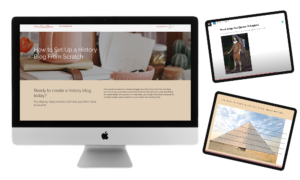You’re buzzing and ready to start your next fabulous history blog post. But, as you get going, your energy starts to go down, distractions creep in and before long this little voice is saying
“Seriously, why does every post take so {insert expletive} long.”
Feeling like it’s taking too long to write and get your post into the world can be deflating. It’s also confusing especially when you know you’ve picked a history blog topic you love. The 25 tips I’ve set out are perfect if you want to blog a bit quicker but don’t quite know how. So, read on and let’s make sure your history blogging experience is creative, not frustrated.
25 ways to write your history blog post faster
Prepare
- Duplicate your last post and overwrite it so you don’t have to add in repetitive blocks
- I know it’s hard because history is such a joy to learn but time limit your research time
- Have an editorial calendar so you know what you’re going to write about at each session
- Limit your scope and your images
- Create an outline with headings
- Know your Call to Action (CTA) i.e where you want to send readers at the end
- Set one outcome
- Organise your research, use a notes function to grab any URLS you may need later
- Know what you want to share with your reader in one sentence.
- Look up your keyword before you start writing. Try Ubersuggest or Keywords Everywhere
Related Link: Are these 7 Keywords Research Mistakes Holding Back Your History Blog?
Build in flexibility
- Do a bite-size version if your priority is momentum or time is limited
- Adapt the style of post. Break text up with embedded content (podcast audio, YouTube video)
- Be prepared to pivot if sources, images or ideas are hard to come by
- Do a review and critique someone else’s content rather than writing an original
- If it’s not working out for you then stop and move on. Maybe get the webpage ready or some social media graphics.
Related Post: 35 Ideas for Blog Posts
Be kind to yourself
- Make sure you’re comfortable, hydrated and not hungry – don’t work against your natural energy.
- Pick a subject you want to write about not what you think you should be
- Don’t try and multi-task it hurts your brain. Separate your research from writing
- Eliminate all distractions
- Avoid perfectionism. Done is better than perfect. Remember, it’s your history blog. All posts can be corrected or updated later if needed
- Write or record your ideas in the moment especially if you’ve just read, watched or visited something.
Resist what can wait
- Don’t choose your feature image until the very end
- Don’t edit as you go along
- If I don’t know something when I’m writing I just put an X. You will lose momentum if you stop look up whether Queen Victoria died in 1901 or 1902.
- Pick a style but nail your precise wording for your title fully at the end just have a rough idea
Related Post: Want irresistibly clickable posts. Try these 6 types of history blog post titles
Getting faster at blogging starts with building awareness around what is making you slower. And, it’s cliche but the more you blog the faster you’ll get as these techniques become a normal part of your blogging process. If you want extra ways to have more to show at the end of your history blogging sessions then check out my FREE mini-training “Stop Wasting Time and Get More Done on Your History Blog.”




